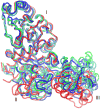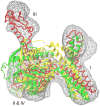Consensus among flexible fitting approaches improves the interpretation of cryo-EM data
- PMID: 22019767
- PMCID: PMC3288178
- DOI: 10.1016/j.jsb.2011.10.002
Consensus among flexible fitting approaches improves the interpretation of cryo-EM data
Abstract
Cryo-elecron microscopy (cryo-EM) can provide important structural information of large macromolecular assemblies in different conformational states. Recent years have seen an increase in structures deposited in the Protein Data Bank (PDB) by fitting a high-resolution structure into its low-resolution cryo-EM map. A commonly used protocol for accommodating the conformational changes between the X-ray structure and the cryo-EM map is rigid body fitting of individual domains. With the emergence of different flexible fitting approaches, there is a need to compare and revise these different protocols for the fitting. We have applied three diverse automated flexible fitting approaches on a protein dataset for which rigid domain fitting (RDF) models have been deposited in the PDB. In general, a consensus is observed in the conformations, which indicates a convergence from these theoretically different approaches to the most probable solution corresponding to the cryo-EM map. However, the result shows that the convergence might not be observed for proteins with complex conformational changes or with missing densities in cryo-EM map. In contrast, RDF structures deposited in the PDB can represent conformations that not only differ from the consensus obtained by flexible fitting but also from X-ray crystallography. Thus, this study emphasizes that a "consensus" achieved by the use of several automated flexible fitting approaches can provide a higher level of confidence in the modeled configurations. Following this protocol not only increases the confidence level of fitting, but also highlights protein regions with uncertain fitting. Hence, this protocol can lead to better interpretation of cryo-EM data.
Copyright © 2011 Elsevier Inc. All rights reserved.
Figures




Similar articles
-
Consensus among multiple approaches as a reliability measure for flexible fitting into cryo-EM data.J Struct Biol. 2013 May;182(2):67-77. doi: 10.1016/j.jsb.2013.02.002. Epub 2013 Feb 13. J Struct Biol. 2013. PMID: 23416197
-
Protein-Protein Modeling Using Cryo-EM Restraints.Methods Mol Biol. 2020;2112:145-162. doi: 10.1007/978-1-0716-0270-6_11. Methods Mol Biol. 2020. PMID: 32006284
-
Accurate flexible fitting of high-resolution protein structures into cryo-electron microscopy maps using coarse-grained pseudo-energy minimization.Biophys J. 2011 Jan 19;100(2):478-88. doi: 10.1016/j.bpj.2010.12.3680. Biophys J. 2011. PMID: 21244844 Free PMC article.
-
Advancing cryo-electron microscopy data analysis through accelerated simulation-based flexible fitting approaches.Curr Opin Struct Biol. 2023 Oct;82:102653. doi: 10.1016/j.sbi.2023.102653. Epub 2023 Jul 12. Curr Opin Struct Biol. 2023. PMID: 37451233 Review.
-
Tools for the cryo-EM gold rush: going from the cryo-EM map to the atomistic model.Biosci Rep. 2017 Dec 5;37(6):BSR20170072. doi: 10.1042/BSR20170072. Print 2017 Dec 22. Biosci Rep. 2017. PMID: 28963369 Free PMC article. Review.
Cited by
-
Collective variable approaches for single molecule flexible fitting and enhanced sampling.Chem Rev. 2014 Mar 26;114(6):3353-65. doi: 10.1021/cr4005988. Epub 2014 Jan 21. Chem Rev. 2014. PMID: 24446720 Free PMC article. Review. No abstract available.
-
Cryo_fit: Democratization of flexible fitting for cryo-EM.J Struct Biol. 2019 Oct 1;208(1):1-6. doi: 10.1016/j.jsb.2019.05.012. Epub 2019 Jul 3. J Struct Biol. 2019. PMID: 31279069 Free PMC article.
-
Flexible Fitting of Atomic Models into Cryo-EM Density Maps Guided by Helix Correspondences.Biophys J. 2017 Jun 20;112(12):2479-2493. doi: 10.1016/j.bpj.2017.04.054. Biophys J. 2017. PMID: 28636906 Free PMC article.
-
Automated Modeling and Validation of Protein Complexes in Cryo-EM Maps.Methods Mol Biol. 2021;2215:189-223. doi: 10.1007/978-1-0716-0966-8_9. Methods Mol Biol. 2021. PMID: 33368005 Review.
-
Computational methods for constructing protein structure models from 3D electron microscopy maps.J Struct Biol. 2013 Oct;184(1):93-102. doi: 10.1016/j.jsb.2013.06.008. Epub 2013 Jun 21. J Struct Biol. 2013. PMID: 23796504 Free PMC article.
References
-
- Bahar I, Atilgan AR, Erman B. Direct evaluation of thermal fluctuations in proteins using a single-parameter harmonic potential. Fold Des. 1997;2:173–181. - PubMed
-
- Campbell ID. Timeline: the march of structural biology. Nat Rev Mol Cell Biol. 2002;3:377–381. - PubMed
-
- Chacon P, Wriggers W. Multi-resolution contour-based fitting of macromolecular structures. J Mol Biol. 2002;317:375–384. - PubMed
-
- Clementi C, Nymeyer H, Onuchic JN. Topological and energetic factors: what determines the structural details of the transition state ensemble and “en-route” intermediates for protein folding? An investigation for small globular proteins. J Mol Biol. 2000;298:937–953. - PubMed
Publication types
MeSH terms
Substances
Grants and funding
LinkOut - more resources
Full Text Sources

